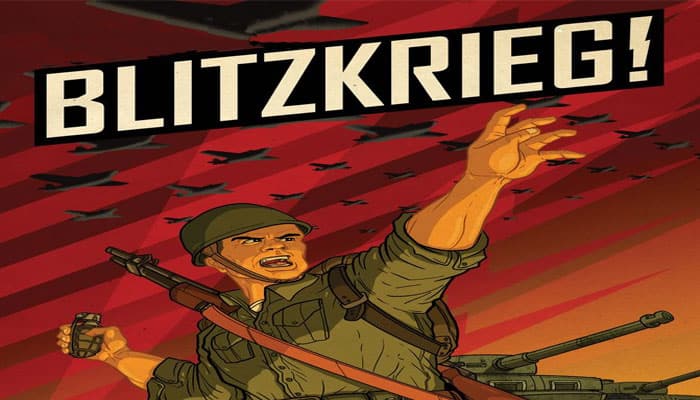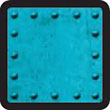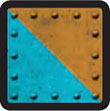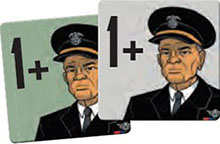
In Blitzkrieg! two players, acting respectively as the Allied and Axis coalitions during World War Two, battle for control of the main theaters of the conflict in a challenging game with simple rules, a short playing time, and many tough decisions!
Players draw unit tokens from a bag to determine their starting forces and to replenish their losses.
Rather than fighting battles with dice or cards, players allocate their military resources to each theater's campaigns, winning war victory points, gaining further resources and special weapons, and exploiting strategic advantages as they play.
Refight the whole of World War Two several times in one evening!
Components
- 1 game board
- 22 Axis unit tokens
- 22 Allied unit tokens
- 16 special weapons tokens
- 2 player screens
- 5 battle markers
- 2 war victory markers
- 2 cloth bags
- Solo module
- Rulebook
Game Elements
Game Board

Theaters of Operations, Campaigns, Battle Spaces, and Battle Tracks.
-
The board shows five different theaters of operations where the conflict will be fought.
-
Each theater of operations is made of a number (two or three) of campaigns. Each campaign is represented by a row of battle spaces, that can be occupied by the unit tokens of either player during the game.
-
An active campaign is the topmost campaign in each theater of operations with at least one unoccupied battle space. Players can only place their unit tokens on any unoccupied battle space in the active campaign of any theater of operations.

-
A closed campaign is a row of battle spaces that have been all occupied by unit tokens.
-
At the top of each theater of operations is a battle track. The position of the battle marker on the battle track shows what coalition is currently winning the theater of operations.
Battle spaces can be of three different types.

Land spaces: Can only be occupied by armies or airforces.

Sea spaces: Can only be occupied by navies or airforces.

Land/sea spaces: Can be occupied by armies, navies, or airforces.
Unit Tokens
Each player starts the game with a supply of unit tokens (grey tokens for the Axis player; green tokens for the Allied player). The rules for special weapons tokens (yellow tokens) are explained in the next section.

Armies: Can be placed on land battle spaces and land/sea battle spaces.

Navies: Can be placed 3on sea battle spaces and land/sea battle spaces.

Airforces: Can be placed on any type of battle space.

Blitz airforces: Can be placed on any type of battle space. After placing a blitz airforce, you can immediately place another unit token from your reserve to an eligible battle space in the same theater of operations.
Note: Even if you played more than one unit token, you'll get to draw only one unit token in the draw phase at the end of your turn.

General: The general is considered an army. Advance one space on the battle track for each army and airforce you have already deployed in this theater of operations (including the general but ignoring special weapons).

Admiral: The admiral is considered a navy. Advance one space on the battle track for each navy and airforce you have already deployed in this theater of operations (including the admiral but ignoring special weapons).
Special Weapons Tokens
During the game, due to the effect of research battle spaces, players will gain access to new unit tokens called special weapons. The rules for these tokens are explained below.
-

Elite forces: These are just unit 2tokens with better values.
-

Task forces: When you place these unit tokens, ignore the effect of the occupied battle space.
-

Blitz forces: After you place (and resolve) one of these unit tokens, you can immediately place another unit token from your reserve to an eligible battle space in the same theater of operations.
Note: Even if you played more than one unit token, you'll get to draw only one unit token in the draw phase at the end of your turn.
-

Naval bombing / Aerial bombing: When you carry out the effect of the battle space, also carry out a bombing effect (discard one random unit token from your opponent's reserve).
-

Nuclear bomb: The nuclear bomb is considered an army. When you place the nuclear bomb, advance seven spaces on the theater of operations battle track, and retreat two spaces on all other theaters of operations battle tracks that are not yet closed.
-

Spy: Copy the value, type (army, navy, airforce), and any special ability of the unit token just placed by y1our opponent.
-

Scientist: You can place the scientist on any battle space (not only the topmost open campaign) of a theater of operations of your choice to carry out its effect.
The scientist has no military value, so you don't get to move the battle marker.
Setup
-
Open the gameboard in the middle of the table.
-
Place a battle marker on the middle (red) space of each battle track.
-
Decide who will be the Axis coalition player, and who will be the Allied coalition player. Each player takes a player screen and places his unit tokens in his bag.
-
Each player shuffles his unit tokens in his bag and draws three. These are kept hidden from your opponent, behind your player screen. The tokens behind your screen are called your "reserve".
-
Place the two war victory markers next to the war victory track.
-
Shuffle the special weapons tokens and place them face down next to the game board. This is called the "research pile".
-
The Axis player takes the first turn of the game.
Game Play
Players alternate in taking turns.
On your turn, carry out the following phases:
-
Place a unit token from your reserve on a free battle space.
-
Carry out the effect shown on the battle space you have just occupied.
-
Move the battle marker toward your end of the corresponding battle track a number of spaces equal to the value of the unit token you have just played.
-
Draw a new unit token from the bag and place it in your reserve.
1. Place a unit token
Take one unit token from your reserve (behind your screen), and place it on any unoccupied battle space in the topmost open campaign (i.e. a campaign with at least one free battle space) of any theater of operations.
Armies can be placed on land battle spaces and land / sea battle spaces.
Navies can be placed on sea battle spaces and land / sea bat0tle spaces.
Airforces can be placed on an type of battle space.

Units must be always be placed in the topmost open campaign of a theater of operations.
2. Carry out the battle space effect
On most of the battle spaces an icon is depicted, representing the effect that must be carried out by the player that occupies it with one of his unit tokens. This effect must be carried out immediately after the unit token is placed.
If a battle space has no icons on it, it can still be occupied by a unit token, but it won't trigger any type of effect when occupied.
-

Industrial production: Draw one unit token from your bag and add it to your reserve.
-

Bombing: Discard (put back in the bag) one random unit token from your opponent's reserve.
-

Research:: Draw one random unit token from the research pile, and add it to your bag.
-

Tactical advantage: Advance this number of spaces on the battle track of the theater of operations where you just placed your unit token.
-

Strategic advantage: Advance this number of spaces on the battle track of any theater of operations except the one where you just placed your unit token. You cannot move onto the last space of a track with this effect.
-

Propaganda: Advance this number of spaces on the war victory track.
-

Improved industrial production: Draw two unit tokens from your bag and add them to your reserve.
-

Research industry: Draw one random unit token from the research pile, and add it directly to your reserve.
-

Improved research: Draw two random unit tokens from the research pile, and add them to your bag.
3. Move the battle marker
Move the battle marker of the corresponding battle track toward your end (the Allied roundel icon if you are the Allied player; the Axis cross icon if you are the Axis player) a number of spaces equal to the value of the unit token you just placed.

The Axis player previously placed a 1-strength navy token and moved the battle marker one space in her favor. The Allied player now places a 3-strength army token and moves the battle marker three spaces in his favor.
Closing and winning a campaign
If you occupied with your unit token the last battle space of a campaign (i.e. the final vacant battle space in the row), that campaign is closed.
Check whose side of the battle track the battle marker is currently on: that player immediately advances his war victory marker a number of spaces equal to the campaign victory points depicted next to the current campaign row.
Moreover, the winning player scores additional war victory points if the victory point icons (worth one war victory point at the first icon, and one more at the second icon) are reached by the battle marker on his side of the track.
Note: When a campaign closes and the battle marker is on the neutral space at the center of the battle track, both players advance their war victory markers a number of spaces equal to the campaign victory points.

The Allied player places a 3-strength army to close this campaign. He moves the battle marker three spaces in his favor, gaining one war victory point from the victory point icon on the battle track, and gains a further two war victory points for closing this campaign.
Closing a theater of operations
If, as a consequence of placing your unit token, you move the battle marker onto the very last space on your side of the battle track, you immediately close and win the theater of operations. If this happens:
All the campaigns of the corresponding theater of operations are considered closed.
Immediately car0ry out the effect, in any order2you prefe2r, of all the unoccupied battle spaces of the corresponding theater of operations.
Score the war victory points shown next to each campaign you have clos0ed in this way.
Note: You cannot close and win a theater of operations with the strategic advantage effect of a battle space. If this effect would allow a player to advance to the last space of a battle track, the marker is instead stopped at the penultimate space

The Allied player places a unit that moves the battle marker to the very last space on the battle track. This closes the theater of operations!
4. Draw a new unit token
Draw a new unit token from your bag and add it to your reserve.
Reserve Size
During the game, the number of unit tokens in the reserve of each player can vary. Each reserve starts with three unit tokens, but due to the effects of industrial production, bombing, and so on, the reserve can increase or decrease in size, and offer players better or worse choices of available troops.
Battle Space Effects
-

Industrial production: Draw one unit token from your bag and add it to your reserve.
-

Bombing: Discard (put back in the bag) one random unit token from your opponent's reserve.
-

Research: Draw one random unit token from the research pile, and add it to your bag.
-

Tactical advantage: Advance this number of spaces on the battle track of the theater of operations where you just placed your unit token.
-

Strategic advantage: Advance this number of spaces on the battle track of any theater of operations except the one where you just placed your unit token. You cannot move onto the last space of a track with this effect.
-

Propaganda: Advance this number of spaces on the war victory track.
-

Improved industrial production: Draw two unit tokens from your bag and add them to your reserve.
-

Research industry: Draw one random unit token from the research pile, and add it directly to your reserve.
-

Improved research: Draw two random unit tokens from the research pile, and add them to your bag.
End of the Game
The game ends if either of these conditions occur:
-
A player has 25 or more war victory points at the end of his turn.
If the Axis player first reaches 25 war victory points, the Allied player gets one final turn, and the player with the most war victory points is the winner.
If the Allied player first reaches 25 war victory points, he is the winner of the game.
If both players are tied on 25 or more war victory points, the Allied player is the winner.
-
At the beginning of his turn, a player cannot place any unit tokens (he doesn't have any in his reserve, or the unit tokens in his reserve cannot be placed). His opponent is immediately declared the winner.
Continue Reading
